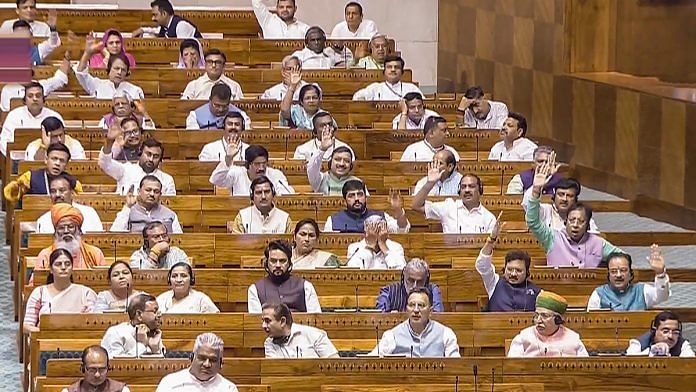Thank you dear subscribers, we are overwhelmed with your response.
Your Turn is a unique section from ThePrint featuring points of view from its subscribers. If you are a subscriber, have a point of view, please send it to us. If not, do subscribe here: https://theprint.in/subscribe/
General elections 2024 are done and dusted. Beating all expectations, the Indian National Congress has won 99 seats – to limit the Bhartiya Janata Party (BJP) to only 240 seats, 32 short of the required majority. Consequently, the BJP was compelled to form the National Democratic Alliance (NDA) coalition government with several regional political parties. Coalition dharma dictates that the new NDA must reach a consensus on key reforms, to govern smoothly for the next five years. One pivotal area where consensus is both vital and feasible is the reforms pertaining to the judiciary.
The judiciary stands as one of the most independent institutions in India. Throughout India’s brief but significant post-independence history, the judiciary has played an important role and steadfastly defended liberal principles enshrined in the constitution. This commitment continues to this day, with the recent judgment on the legality of electoral bonds. By consistently acting as a check on the executive and the legislative branches, the judiciary has reinforced its position as a guardian of constitutional values. However, this brings. A crucial question that is often overlooked: Who oversees the judiciary?
The short answer: no one. Currently, the courts in India operate with minimal checks and balances, which is increasingly evident. In recent years, the judiciary has assumed roles typically reserved for the executive, often issuing orders to the government under “emergency” circumstances. During the COVID-19 pandemic, the Delhi High Court conducted daily hearings to ensure that hospitals in Delhi had access to oxygen cylinders. A Calcutta high court bench recently directed the state government to formulate a policy, guaranteeing reservation for transgenders. During farm protests, the Supreme Court stayed the implementation of the controversial farm laws passed by the parliament. Recently, the Madras High Court objected to lawyers advertising their services online. While many view these interventions as righteous, they fall outside the judiciary’s responsibilities. More importantly, they sometimes allow the government to escape accountability, as seen with the NEET controversy.
The primary role of the judiciary should be to adjudicate millions of pending cases, including those that require interpretation of existing laws. Unlike, courts in Western democracies which generally handle constitutional matters, the Supreme Court of India hears hundreds of cases daily and frequently overturns rulings by lower courts. This extensive caseload suggests a lack of trust in the judicial system, especially considering that the Supreme Court itself appoints justices in the high courts. Another critical function of the court’s job is to ensure that both the government and the high court strictly adhere to their written orders, which has not been the case recently. Instead of focusing on these core responsibilities, the Indian courts often entertain frivolous Public Interest Litigations (PILs) filed mainly by political parties or their proxies to achieve their objectives.
The courts also suffer from a lack of continuity. The Chief Justice of India, who decides the court’s priorities, has had very short tenures, especially in the last decade. However, continuity has proven to be beneficial to the court, as evidenced by the current Chief Justice D.Y Chandrachud’s tenure. Within just one and a half years, he has ruled on legal issues that have been plaguing the judiciary for more than 5 years. His tenure, expected to last a little more than two years, is a record considering the court’s recent history.
Indian judiciary’s greatest moments have invariably arrived when the courts have focused on core responsibilities. Ensuring that the judiciary continues to perform effectively requires accountability, but not at the expense of its independence. Therefore, meaningful reforms in the judiciary should be achieved through broad consensus across the political parties, the judiciary, and the Indian electorate. With the commencement of the 18th Lok Sabha, there is a unique opportunity to implement such reforms, as there appears to be consensus on policy regarding this issue. The Congress party’s manifesto for the Lok Sabha elections had proposed judicial reforms with two notable aspects: first, separation of the Supreme Court into constitutional and civil courts; second, appointment of justices through the National Judicial Commission (NJC) which was to be established after extensive consultations with the Supreme Court. Interestingly, the Congress’s second proposal closely resembles the National Judicial Appointments Commission (NJAC), which was established by the BJP in 2014 to oversee the appointment of justices in the High Court and the Supreme Court. The NJAC aimed to place judicial appointments under the joint oversight of the legislature and executive, without compromising on autonomy. However, the supreme courts, in its wisdom, stuck down the law, citing violation of the “basic structure doctrine” to invalidate the legality of the commission.
To override the basic structure doctrine, any significant reform, aimed at introducing accountability now requires a two-thirds majority in the parliament. In the 18th Lok Sabha, this necessitates collaboration between the incumbent BJP and the Congress party to secure 363 votes needed to pass judicial scrutiny of legislation equal to the NJAC bill. In an era of deep political polarization, judicial accountability is a rare area of agreement between the BJP and the Congress. Will a consensus on policy lead to a consensus on reform? It is uncertain. However, as the 2024 Lok Sabha results have shown, Indian politics is full of surprises.
These pieces are being published as they have been received – they have not been edited/fact-checked by ThePrint


